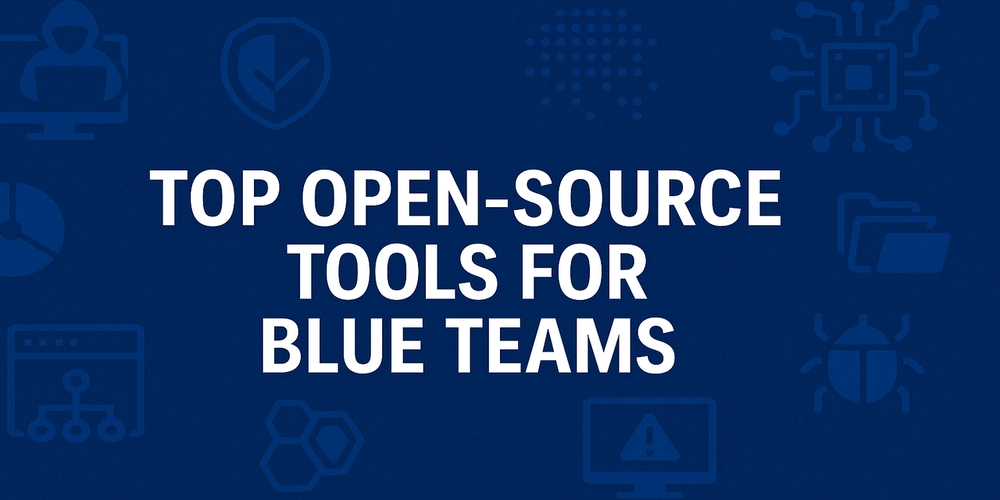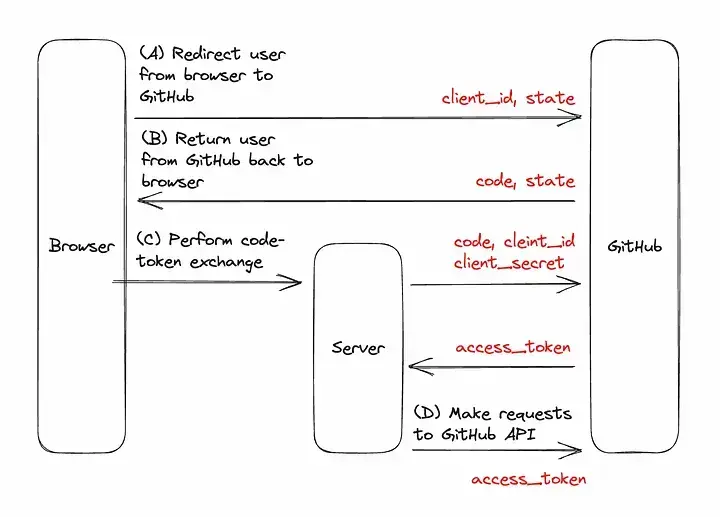Top Open-Source Blue Team Tools: Fortifying Cyber Defenses
Blue Teams are the defenders in the cybersecurity world. Their goal? To defend organizations from cyber attacks, identify suspicious behavior, and respond to incidents efficiently. Although there are numerous costly tools available, there are also strong open-source tools that Blue Teams can utilize — for free! In this post, we're going to look at some of the greatest open-source tools every Blue Team should be familiar with. Whether you're employed by a big firm or are just starting out, these tools can make a significant impact on your security stance. Prefer watching instead of reading? Here’s a quick video guide What is a Blue Team? Let's first cover the basics before we go into the tools: A Blue Team is a collection of cybersecurity professionals whose mission is to defend an organization's information systems. Some of their roles are: Monitoring systems for unusual activity Fixing bugs Assessing vulnerabilities Conducting incident response plans Intensifying security controls Simple as that. Blue Teams = Cyber Defenders. Why Open-Source Tools? Several benefits come from using open-source tools: Free to use – perfect for budget-constrained organizations. Community-driven – continuous updating and enhancements. Transparent – anyone can see the code for security and trust. Let's now consider the best open-source tools Blue Teams use. Security Onion – Complete Threat Detection Platform What it does: Security Onion is a Swiss Army knife for Blue Teams. It's an entire Linux distro packed with intrusion detection, network security monitoring, and log management tools. Key Features: Real-time network traffic analysis Host-based intrusion detection (HIDS) Full packet capture Threat hunting functionality Included tools: Zeek, Suricata, Wazuh, and more Why Blue Teams Love It: It provides an integrated, all-in-one platform that consolidates many of the most important functions. You can detect intrusions, analyze incidents, and track network activity — all within one system. Wazuh – Security Monitoring and Threat Detection What it does: Wazuh is an open-source security solution that assists in monitoring your systems for threats, vulnerabilities, and compliance. Key Features: File integrity monitoring (identifies unauthorized modifications) Intrusion detection Vulnerability detection Security information and event management (SIEM) integration Cloud security monitoring Why Blue Teams Love It: It provides visibility into what’s happening on endpoints and servers. Plus, it integrates well with tools like Elastic Stack (Elasticsearch, Logstash, Kibana). Zeek (formerly Bro) – Network Traffic Analysis What it does: Zeek isn’t just a simple intrusion detection system; it’s a powerful network analysis framework. It watches your network traffic and generates detailed logs. Key Features: Protocol analysis (HTTP, DNS, SSL, FTP, etc.) Connection logging File extraction from network traffic Scripting capability for custom detections Why Blue Teams Love It: Zeek enables defenders to comprehend network activity deeply. It doesn't only alert; it narrates the story behind traffic. TheHive – Incident Response Platform What it does: TheHive is an open-source Security Incident Response Platform (SIRP) designed to assist Blue Teams in effectively managing and responding to incidents. Key Features: Case management (track investigations) Collaboration features (assign tasks to team members) Integration with MISP (threat intelligence sharing) Playbooks for automated workflows Why Blue Teams Love It: Incident management can become messy. TheHive introduces order and collaboration, ensuring no incident slips through the cracks. Velociraptor – Endpoint Visibility and Threat Hunting What it does: Velociraptor is a digital forensics and incident response (DFIR) tool. You can quickly search across numerous endpoints and gather forensic information. Key Features: Search for indicators of compromise (IoCs) on systems Remote live forensic collection Query endpoints with Velociraptor Query Language (VQL) Lightweight and scalable Why Blue Teams Love It: Time is of the essence when you're investigating an attack. Velociraptor assists you in collecting valuable information rapidly, even from thousands of machines. OSQuery – Operating System as a Database What it does: OSQuery lets you query your operating system as if it were a database. Want to see what processes are running or what USB devices were inserted? Just execute a SQL query. Key Features: Cross-platform compatibility (Windows, Linux, macOS) Scheduled queries with real-time monitoring Simple integration with other tools Why Blue Teams Love It: It offers a straightforward, powerful means of monitoring systems for suspicious behavior using well-known SQL-style queries. YARA – Ma

Blue Teams are the defenders in the cybersecurity world. Their goal? To defend organizations from cyber attacks, identify suspicious behavior, and respond to incidents efficiently. Although there are numerous costly tools available, there are also strong open-source tools that Blue Teams can utilize — for free!
In this post, we're going to look at some of the greatest open-source tools every Blue Team should be familiar with. Whether you're employed by a big firm or are just starting out, these tools can make a significant impact on your security stance.
Prefer watching instead of reading? Here’s a quick video guide
What is a Blue Team?
Let's first cover the basics before we go into the tools:
A Blue Team is a collection of cybersecurity professionals whose mission is to defend an organization's information systems. Some of their roles are:
Monitoring systems for unusual activity
- Fixing bugs
- Assessing vulnerabilities
- Conducting incident response plans
- Intensifying security controls
Simple as that. Blue Teams = Cyber Defenders.
Why Open-Source Tools?
Several benefits come from using open-source tools:
- Free to use – perfect for budget-constrained organizations.
- Community-driven – continuous updating and enhancements.
- Transparent – anyone can see the code for security and trust.
Let's now consider the best open-source tools Blue Teams use.
Security Onion – Complete Threat Detection Platform
What it does: Security Onion is a Swiss Army knife for Blue Teams. It's an entire Linux distro packed with intrusion detection, network security monitoring, and log management tools.
Key Features:
- Real-time network traffic analysis
- Host-based intrusion detection (HIDS)
- Full packet capture
- Threat hunting functionality
- Included tools: Zeek, Suricata, Wazuh, and more
Why Blue Teams Love It: It provides an integrated, all-in-one platform that consolidates many of the most important functions. You can detect intrusions, analyze incidents, and track network activity — all within one system.
Wazuh – Security Monitoring and Threat Detection
What it does: Wazuh is an open-source security solution that assists in monitoring your systems for threats, vulnerabilities, and compliance.
Key Features:
- File integrity monitoring (identifies unauthorized modifications)
- Intrusion detection
- Vulnerability detection
- Security information and event management (SIEM) integration
- Cloud security monitoring
Why Blue Teams Love It: It provides visibility into what’s happening on endpoints and servers. Plus, it integrates well with tools like Elastic Stack (Elasticsearch, Logstash, Kibana).
Zeek (formerly Bro) – Network Traffic Analysis
What it does: Zeek isn’t just a simple intrusion detection system; it’s a powerful network analysis framework. It watches your network traffic and generates detailed logs.
Key Features:
- Protocol analysis (HTTP, DNS, SSL, FTP, etc.)
- Connection logging
- File extraction from network traffic
- Scripting capability for custom detections
Why Blue Teams Love It: Zeek enables defenders to comprehend network activity deeply. It doesn't only alert; it narrates the story behind traffic.
TheHive – Incident Response Platform
What it does: TheHive is an open-source Security Incident Response Platform (SIRP) designed to assist Blue Teams in effectively managing and responding to incidents.
Key Features:
- Case management (track investigations)
- Collaboration features (assign tasks to team members)
- Integration with MISP (threat intelligence sharing)
- Playbooks for automated workflows
Why Blue Teams Love It: Incident management can become messy. TheHive introduces order and collaboration, ensuring no incident slips through the cracks.
Velociraptor – Endpoint Visibility and Threat Hunting
What it does: Velociraptor is a digital forensics and incident response (DFIR) tool. You can quickly search across numerous endpoints and gather forensic information.
Key Features:
- Search for indicators of compromise (IoCs) on systems
- Remote live forensic collection
- Query endpoints with Velociraptor Query Language (VQL)
- Lightweight and scalable
Why Blue Teams Love It: Time is of the essence when you're investigating an attack. Velociraptor assists you in collecting valuable information rapidly, even from thousands of machines.
OSQuery – Operating System as a Database
What it does: OSQuery lets you query your operating system as if it were a database. Want to see what processes are running or what USB devices were inserted? Just execute a SQL query.
Key Features:
- Cross-platform compatibility (Windows, Linux, macOS)
- Scheduled queries with real-time monitoring
- Simple integration with other tools
Why Blue Teams Love It: It offers a straightforward, powerful means of monitoring systems for suspicious behavior using well-known SQL-style queries.
YARA – Malware Detection Rules
What it does: YARA is a tool aimed at helping malware researchers identify and classify malware samples.
Key Features:
- Write custom rules to detect files, processes, or network traffic
- Great for threat hunting and malware analysis
- Lightweight and flexible
Why Blue Teams Love It: YARA rules allow defenders to create targeted detections for new threats. It’s like writing your own security signatures.
GRR Rapid Response – Remote Live Forensics
What it does: GRR (created by Google) is an incident response system that allows remote live forensics and investigations on thousands of machines.
Key Features:
- Remote access to file systems
- Memory analysis
- Analysis of timelines
- Scalable architecture
Why Blue Teams Love It: GRR significantly speeds up and simplifies investigating across a large fleet of machines.
Kibana – Visualization for Logs and Alerts
What it does: Kibana, which is part of the Elastic Stack, aids Blue Teams in visualizing and uncovering log data using dashboards and charts.
Major Features:
- Construct interactive dashboards
- Real-time visualization of data
- Semantic search and analytics
Why Blue Teams Adore It: Visualization makes it easier to detect anomalies. With Kibana, you can immediately identify trends, spikes, and unusual patterns in your security data.
Conclusion
Protecting an organization from cyber attacks is a daunting task, but the right tools can simplify things significantly. Open-source tools empower Blue Teams to detect, analyze, and respond to threats without overexerting the budget.
Quick rundown of the tools
- Security Onion: Update complete monitoring of the network and intrusion detection
- Wazuh: Monitoring of endpoints and threat detection
- Zeek: Update analysis of network traffic
- TheHive: Management of incident response
- Velociraptor: Endpoint visibility and hunting of threats
- OSQuery: Query systems such as databases
- YARA: Detection of malware via custom rules
- GRR Rapid Response: Forensic investigations remotely
- Kibana: Visualization of logs
Keep in mind: No one tool is sufficient. The strongest defense is obtained by using these tools in conjunction with each other and building a layered security approach.




























































































































































![[The AI Show Episode 143]: ChatGPT Revenue Surge, New AGI Timelines, Amazon’s AI Agent, Claude for Education, Model Context Protocol & LLMs Pass the Turing Test](https://www.marketingaiinstitute.com/hubfs/ep%20143%20cover.png)






























































































































![[FREE EBOOKS] AI and Business Rule Engines for Excel Power Users, Machine Learning Hero & Four More Best Selling Titles](https://www.javacodegeeks.com/wp-content/uploads/2012/12/jcg-logo.jpg)








































































































































































































































![Hostinger Horizons lets you effortlessly turn ideas into web apps without coding [10% off]](https://i0.wp.com/9to5mac.com/wp-content/uploads/sites/6/2025/04/IMG_1551.png?resize=1200%2C628&quality=82&strip=all&ssl=1)


![This new Google TV streaming dongle looks just like a Chromecast [Gallery]](https://i0.wp.com/9to5google.com/wp-content/uploads/sites/4/2025/04/thomson-cast-150-google-tv-1.jpg?resize=1200%2C628&quality=82&strip=all&ssl=1)













![Apple Drops New Immersive Adventure Episode for Vision Pro: 'Hill Climb' [Video]](https://www.iclarified.com/images/news/97133/97133/97133-640.jpg)

![Most iPhones Sold in the U.S. Will Be Made in India by 2026 [Report]](https://www.iclarified.com/images/news/97130/97130/97130-640.jpg)




































































































































